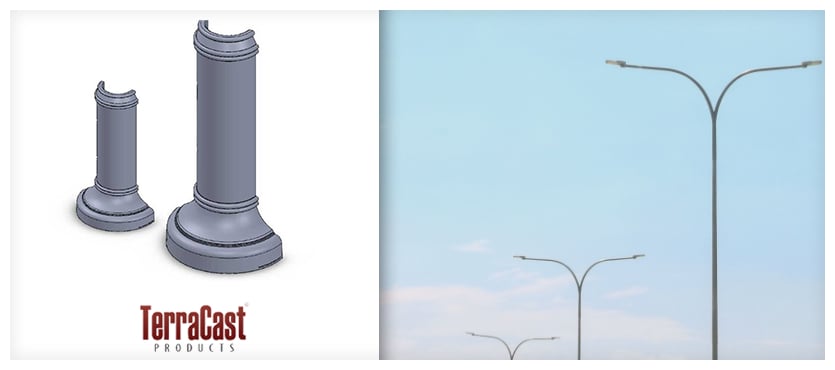Urban infrastructure is built to last—but not all materials stand the test of time. For decades, metal street fixtures such as benches, light pole bases, and planters have been staples in cityscapes across the country. While they offer strength and a sleek aesthetic, the long-term costs of corrosion, maintenance, and environmental exposure have become increasingly difficult for cities to ignore.
As municipal budgets tighten and infrastructure demands grow, many cities are re-evaluating the materials they rely on for public furnishings. Resin-based alternatives are gaining traction as a smarter, longer-lasting solution. Free from the vulnerabilities of rust and oxidation, resin products offer durability, low maintenance, and aesthetic flexibility—without the hidden costs of metal degradation.
Understanding the True Cost of Metal Fixtures
Metal fixtures—especially those made from steel and iron—can look sharp when first installed. But exposure to moisture, road salts, pollutants, and even caustic dog urine begins a gradual process of corrosion that not only deteriorates the material but also affects the safety and appearance of public spaces.
Rust weakens structural integrity and leads to costly repairs or premature replacement. In coastal cities or regions with harsh winters, corrosion happens even faster due to salt-laden air or aggressive de-icing treatments. These frequent maintenance cycles strain city budgets and redirect valuable resources from other public projects.
In addition, corroded benches or light pole bases pose safety risks to pedestrians. Sharp edges, crumbling components, and structural failures can result in injury and legal liability—adding another layer of cost for cities to absorb.
Labor and Maintenance: A Hidden Drain on Resources
It’s not just the materials that cost money—ongoing maintenance of metal infrastructure involves labor, equipment, and time. City workers must regularly inspect, clean, sand, prime, and repaint metal fixtures to keep corrosion at bay. These tasks become recurring expenses that add up year after year.
In many cases, when rust becomes too advanced, patchwork repairs are no longer viable, and the entire fixture must be replaced. This cycle repeats across thousands of street fixtures in urban environments, contributing to budget bloat and infrastructure fatigue.
The labor burden is even more significant in large metropolitan areas with extensive public assets or in historic districts that require visually consistent and regularly maintained furnishings.
The Resin Advantage: Durable, Maintenance-Friendly, and Cost-Effective
Unlike metal, resin does not rust, corrode, or degrade when exposed to the elements. Resin products—especially those made from high-quality Linear Low-Density Polyethylene (LLDPE)—are engineered to resist moisture, UV rays, chemicals, and extreme temperatures. These characteristics make resin an ideal choice for cities looking to reduce long-term maintenance and replacement costs.
Because resin doesn’t require painting or protective coatings, the initial investment covers more years of use, with minimal intervention. A simple wipe-down or pressure wash keeps resin planters, benches, and light pole bases looking new—even in high-traffic or graffiti-prone areas.
And while metal street furniture can become dangerously hot or cold depending on the season, resin products maintain a more neutral surface temperature, making them safer and more comfortable for public use.
Environmental and Sustainability Benefits
The long-lasting nature of resin products contributes to sustainability goals by reducing waste and lowering the frequency of replacement cycles. Many resin furnishings are made using recycled materials, supporting eco-conscious city planning and circular manufacturing practices.
Furthermore, since resin products are often lighter than their metal counterparts, they require less fuel for transport and are easier to install—reducing both the environmental impact and logistical costs of urban improvement projects.
Urban Flexibility Without Compromise
Cities are increasingly designing flexible, multi-use public spaces that need versatile and mobile infrastructure. Resin furniture and planters offer this flexibility without sacrificing stability. Their lightweight construction makes them easier to move, reposition, or reconfigure for events, pop-ups, or evolving city needs.
With a wide range of colors, textures, and forms available, resin also provides aesthetic options that blend with historic, contemporary, or mixed-use environments—a key requirement for cities balancing design and functionality.
Moving Toward Smarter, Safer Streets
Corrosion is more than just a cosmetic issue—it’s a costly, ongoing challenge that affects public safety, maintenance budgets, and the overall experience of city life. As urban planners and municipalities look for materials that offer both performance and longevity, resin is emerging as a forward-thinking alternative to traditional metals.
TerraCast® is proud to offer American-made resin light pole bases, planters, and street furniture designed to outlast and outperform conventional materials. Our products deliver durability, beauty, and savings—without the rust. To learn how TerraCast® can help your city cut down on corrosion-related costs, contact us today.

